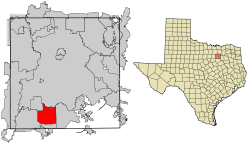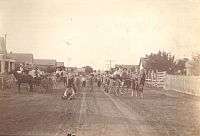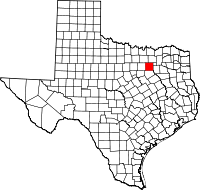DeSoto, Texas
| DeSoto, Texas | |||
|---|---|---|---|
| City | |||
| City of DeSoto | |||
| |||
| Motto: "Live, Work, Play in DeSoto"[1] | |||
 Location of DeSoto in Dallas County, Texas | |||
| Coordinates: 32°35′57″N 96°51′32″W / 32.59917°N 96.85889°WCoordinates: 32°35′57″N 96°51′32″W / 32.59917°N 96.85889°W | |||
| Country |
| ||
| State |
| ||
| County |
| ||
| Incorporated | 1949 | ||
| Government | |||
| • Type | Council-Manager | ||
| • City Council |
Mayor Curtistene McCowan Virgil Helm Deshaundra Lockhart-Jones Rachel Proctor Dick North Candice Quarles James Zander | ||
| • City Manager | Dr.Tarron J. Richardson | ||
| Area | |||
| • Total | 21.6 sq mi (55.9 km2) | ||
| • Land | 21.6 sq mi (55.9 km2) | ||
| • Water | 0 sq mi (0 km2) | ||
| Elevation | 666 ft (203 m) | ||
| Population (2012) | |||
| • Total | 51,102 | ||
| • Density | 2,400/sq mi (910/km2) | ||
| Time zone | Central (UTC-6) | ||
| • Summer (DST) | Central (UTC-5) | ||
| ZIP codes | 75115, 75123 | ||
| Area code(s) | 972 | ||
| FIPS code | 48-20092[2] | ||
| GNIS feature ID | 1373357[3] | ||
| Website | The City of DeSoto, Texas | ||
DeSoto is a city in Dallas County, Texas, in the United States. As of the 2010 census it had a population of 49,047.[4]
DeSoto is a suburb of Dallas and is part of the Best Southwest area, which includes DeSoto, Cedar Hill, Duncanville, and Lancaster.
History
The area was first settled in 1847, making it one of the oldest communities in North Texas. A post office was established in 1881, and the settlement was named DeSoto in honor of Thomas Hernando DeSoto Stewart, a doctor dedicated to the community
By 1885, DeSoto was home to approximately 120 people, a cotton gin, and a general store. Soon after, the population declined to below 50. In 1930, there were 97 people living in the community and several businesses.

After World War II, DeSoto and surrounding areas began to grow. In order to improve the inadequate water distribution system, residents felt the need to incorporate the town. On February 17, 1949, a petition signed by 42 eligible voters was presented to the Dallas County judge requesting an election for incorporation. The vote took place on March 2. Of the 52 people who cast ballots, 50 voted in favor of incorporation and 2 were opposed. On March 3, 1949, the results were entered into the records of the Dallas County Commissioners Court, thereby creating the City of DeSoto. The new city was less than one square mile in size. On March 15, Wayne A. Chowning was elected mayor along with five aldermen. The first city council meeting was held two days later.
The first census conducted after DeSoto's incorporation occurred in 1950. There were 298 people and eight businesses in the city. Following a series of annexations in 1953, the city covered approximately 15 square miles (39 km2). By 1960, the population had grown to 1,969. In 1970, DeSoto was home to 6,617 people and 71 businesses.
During the 1970s, continued growth brought about improvements to the municipal infrastructure, including road construction, and a new water/sewage system. Industrial, commercial, and residential construction also increased.
On October 26, 1974, an election was held to determine the status of Woodland Hills, a small incorporated community located northwest of DeSoto. The result was 221 votes in favor of a merger with DeSoto and 219 opposed. Woodland Hills had a population of 366 at the time of annexation.
The rapid growth that began in the early 1970s was sustained throughout the 1980s. 1980 census figures put the city's population at slightly over 15,000. By 1984, DeSoto had a total of 360 businesses – up from 168 in 1980.
The population surpassed 30,000 in 1990. City development progressed in the following years. A primary example of this was the creation of DeSoto's Town Center. Officials converted an abandoned strip center located at one of the city's main intersections into a unique central business district. Since its opening, the Town Center has become an anchor of the community, housing city hall, the public library and chamber of commerce, along with civic and recreation centers. There is also a 180-seat auditorium and outdoor amphitheater.

Throughout the 1990s, DeSoto experienced a significant change in the demographic composition of the city. In the 1990 census, whites constituted 75.97% of the city's population, but that figure had declined to 48.83% in the 2000 census, and 17.4% non-Hispanic white by 2010. By contrast, the African American population grew rapidly. In 2000, African Americans were 45.53% of the population, up from 20.83% in 1990. Hispanics accounted for 4.98% of the population in 1990 and 7.30% in 2000.
With approximately 45,500 residents as of 2005, DeSoto is the largest and most diverse city in southwest Dallas County.
On June 11, 2006, the National Civic League named DeSoto an "All-America City". The All-America City Award is the nation's oldest community recognition program and recognizes communities whose citizens work together to identify and tackle community-wide challenges and achieve uncommon results.
In 2015, a viral article was published about the growing trend of largely affluent and college-educated African-Americans moving to the Desoto and other Best Southwest communities.[5]
Geography
DeSoto is located at 32°35′57″N 96°51′32″W / 32.59917°N 96.85889°W (32.599286, −96.858828).[6]
According to the United States Census Bureau, the city has a total area of 21.6 square miles (56 km2), all of it land.
Demographics
| Historical population | |||
|---|---|---|---|
| Census | Pop. | %± | |
| 1950 | 298 | — | |
| 1960 | 1,969 | 560.7% | |
| 1970 | 6,617 | 236.1% | |
| 1980 | 15,538 | 134.8% | |
| 1990 | 30,544 | 96.6% | |
| 2000 | 37,646 | 23.3% | |
| 2010 | 49,047 | 30.3% | |
| Est. 2015 | 52,486 | [7] | 7.0% |
As of the 2010 Census, DeSoto had a population of 51,102. 68.6% of the population was Black, 17.4% was non-Hispanic white, 0.4% American Indian and Alaska Native, 0.9% Asian, 1.9% from two or more races. 12.1% of the population was of Hispanic or Latino origin.[9]
As of the census[2] of 2000, there were 37,646 people, 13,709 households, and 10,459 families residing in the city. The population density was 1,744.5 people per square mile (673.5/km²). There were 14,069 housing units at an average density of 652.0 per square mile (251.7/km²). The racial makeup of the city was 48.83% White, 45.53% Black, 0.31% Native American, 1.29% Asian, 0.03% Pacific Islander, 2.56% from other races, and 1.44% from two or more races. Hispanic or Latino of any race were 7.30% of the population.
There were 13,709 households out of which 39.5% had children under the age of 18 living with them, 58.8% were married couples living together, 14.1% had a female householder with no husband present, and 23.7% were non-families. 20.6% of all households were made up of individuals and 6.1% had someone living alone who was 65 years of age or older. The average household size was 2.71 and the average family size was 3.14.
In the city the population was spread out with 28.2% under the age of 18, 7.6% from 18 to 24, 30.2% from 25 to 44, 24.8% from 45 to 64, and 9.3% who were 65 years of age or older. The median age was 36 years. For every 100 females there were 88.7 males. For every 100 females age 18 and over, there were 83.4 males.
The median income for a household in the city was $57,699, and the median income for a family was $66,986. Males had a median income of $41,847 versus $33,179 for females. The per capita income for the city was $25,650. About 4.1% of families and 5.5% of the population were below the poverty line, including 7.8% of those under age 18 and 7.8% of those age 65 or over.
Government

DeSoto is a home-rule city with a council-manager form of government. Under this type of local government, the day-to-day management of the city is directed by a city manager. The city manager is appointed by the city council and serves as chief administrative officer for the city. The city charter states this position will execute the laws and administer the government of the city. Dr. Tarron J. Richardson is the current city manager of DeSoto.
The city council consists of the mayor and six council members. The mayor represents the city as a whole and six council members represent particular districts (places) within the city. All are elected citywide for a term of three years with two-term term limits.
| Current City Council Members[10] | |
| Place 1 | Curtistene McCowan (Mayor) |
| Place 2 | Virgil Helm |
| Place 3 | Deshaundra Lockhart Jones |
| Place 4 | Rachel Proctor (Mayor Pro Tem) |
| Place 5 | Dick North |
| Place 6 | Candice Quarles |
| Place 7 | James Zander |

Mayors
| Term | Mayor |
|---|---|
| 1949–1953 | Wayne A. Chowning |
| 1953 | Willis Dawson |
| 1953–1955 | Floyd Huffstutler |
| 1955–1959 | J. B. Wadlington |
| 1959–1963 | E. G. Anderson |
| 1963–1965 | John Campbell |
| 1965–1967 | Les C. Zeiger |
| 1967–1969 | L. Carroll Moseley |
| 1969–1971 | H. H. Chandler |
| 1971–1972 | Roy Orr |
| 1972–1973 | Robert Nunneley |
| 1973–1977 | Charles Harwell |
| 1977–1979 | Durward Davis |
| 1979–1983 | Willis Russell |
| 1983–1987 | Ernest Roberts |
| 1987–1995 | David Doyle |
| 1995–2001 | Richard Rozier |
| 2001–2007 | Michael Hurtt |
| 2007–2010 | Bobby Waddle |
| 2010–2016 | Carl Sherman |
|2016–Present |Curtistene McCowan |}
City Managers
| Term | City Manager |
|---|---|
| 1964–1970 | Dewayne White |
| 1970–1973 | Jim Pratt |
| 1973–1977 | Joel Larkin |
| 1977–1981 | Dorothy Talley |
| 1981–1984 | Cliff Johnson |
| 1984–1985 | Jim McAlister |
| 1985–1987 | Kerry Sweatt |
| 1987–1992 | Mark Sowa |
| 1992–1993 | Ed Brady (interim) |
| 1993–1994 | Gary Whittle (interim) |
| 1994–1996 | Ron Holifield |
| 1996–1997 | Bill Lindley (interim) |
| 1997–2011 | Jim Baugh |
| 2011–Present | Dr. Tarron J. Richardson |
Education
Most of DeSoto lies within the DeSoto Independent School District. The district has 12 schools (7 Elementary, 3 Middle, a High School and Freshman Campus) that serve approximately 8,000 students. The district's mascot is the eagle.
A small portion of the city is located in the Duncanville Independent School District. Another small portion is in the Dallas Independent School District.
There are several private and parochial schools in or near the city.
Media
The Focus Daily News is a daily newspaper published in DeSoto, Texas, covering Dallas County. It is owned by Publishers Newspapers.[11] It was founded in 1987, and has a daily circulation of 28,065 and a Sunday circulation of 36,297.[12]
City logo
The DeSoto city logo was adopted on August 26, 1976. The logo, a large "D", has the head of an eagle in the middle (the school district's mascot, see above) outlined on the inside. It is featured prominently on the city flag, water towers, and municipal government documents.
 |
Duncanville | Dallas | Dallas |  |
| Cedar Hill | |
Lancaster | ||
| ||||
| | ||||
| Cedar Hill | Glenn Heights | Lancaster |
References
- ↑ "The City of DeSoto, Texas". The City of DeSoto, Texas. Retrieved August 14, 2012.
- 1 2 "American FactFinder". United States Census Bureau. Retrieved 2008-01-31.
- ↑ "US Board on Geographic Names". United States Geological Survey. 2007-10-25. Retrieved 2008-01-31.
- ↑ "Profile of General Population and Housing Characteristics: 2010 Demographic Profile Data (DP-1): DeSoto city, Texas". U.S. Census Bureau, American Factfinder. Retrieved January 12, 2012.
- ↑ http://www.nbcdfw.com/news/local/Affluent-African-Americans-Flocking-To-DeSoto-294232891.html
- ↑ "US Gazetteer files: 2010, 2000, and 1990". United States Census Bureau. 2011-02-12. Retrieved 2011-04-23.
- ↑ "Annual Estimates of the Resident Population for Incorporated Places: April 1, 2010 to July 1, 2015". Retrieved July 2, 2016.
- ↑ "Census of Population and Housing". Census.gov. Retrieved June 4, 2015.
- ↑ http://quickfacts.census.gov/qfd/states/48/4820092.html
- ↑ City of Desoto – City Council. Retrieved 4 July 2006.
- ↑ "Focus Daily News". Focus Daily News. Retrieved August 14, 2012.
- ↑ "Focus Daily News". Nationwide Newspapers. Retrieved August 14, 2012.
External links
- City of DeSoto official website
- DeSoto Chamber of Commerce
- DeSoto Economic Development Corporation
- DeSoto Independent School District
- DeSoto Public Library
- Focus Daily News



